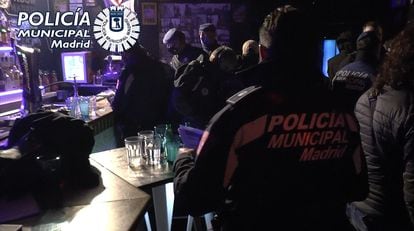What’s really behind Madrid’s improved coronavirus figures?
Experts warn that data being reported may not accurately represent the real situation, as changes in testing methods are affecting the numbers
/cloudfront-eu-central-1.images.arcpublishing.com/prisa/PN45S36JGJBUDFOEB5HEMR6UHI.jpg)

In the last month, Madrid has reduced its coronavirus incidence rate, reported fewer new cases and lowered its positivity rate. The situation in the region’s hospitals, however, has followed a different pattern. The downward trend has been less pronounced in hospitalizations and even less clear with regard to intensive care unit (ICU) admissions and the number of deaths.
The premier of Madrid, Isabel Díaz Ayuso of the conservative Popular Party (PP), argues that the region’s coronavirus restrictions – namely the “surgical” perimetral lockdown of basic healthcare areas – “are working.” But three experts who analyzed the data in Madrid believe that this statement does not completely represent the reality on the ground. According to these experts, there is not enough information to conclude that the region’s measures have been effective.
Incidence rate and diagnostic tests
The Madrid government likes to use the 14-day cumulative number of cases per 100,000 inhabitants to show that contagions in the region are on a downward trend. On September 30, the figure in Madrid stood at 735. By November 10, it had fallen to 339.
But experts warn that this could be due to the introduction of antigen tests, which take less time to process than a PCR but are less sensitive to detecting the virus. Another problem is that the tests – five million of which were bought by the Madrid government – were used in mass testing campaigns, which is precisely the context in which they are not recommended.
Miguel Ángel Royo, a specialist in preventive medicine and the spokesperson for the Spanish Epidemiology Society, says that antigen tests help “control transmission, as they detect cases when they are contagious, require less infrastructure, are cheaper and provide a fast diagnosis, which ensures early isolation.”
The downside, Royo says, is that “you cannot directly compare PCR and antigen data, given that they don’t have the same sensitivity or the same criteria for use.” Due to these issues, the specialist warns that “we have to look with a lot of caution at these figures.”
To assess the effectiveness of the measures that are being applied, we would need the environment of a controlled study and that is not possible in the middle of a pandemicMiguel Ángel Royo, spokesperson for the Spanish Epidemiology Society
The Madrid government began to use antigen tests on September 30 and by November 9, it had carried out 255,087 – just in the large-scale testing campaign. Of this number, only 1,025 returned a positive result. Royo explains: “If you go from a testing in a high-prevalence context, like close contacts, to a low-prevalence one, like the mass testing campaigns, you will detect fewer cases with the same number of tests. If you change the type of test you are using and the criteria for their use, it is very difficult to compare data.”
On September 21, antigen tests were introduced and the number of PCR tests was reduced. The Madrid administration includes figures from both in the official statistics. The region also applied new restrictions aimed at curbing the spread of the virus: social gatherings were reduced from 10 to six people, and it placed various basic healthcare areas – a zone which is smaller than a city district and can include several primary healthcare centers – under a perimetral lockdown. On September 30, the regional government stopped testing all close contacts of positive cases for the coronavirus – instead testing only contacts with symptoms, people who belong to an at-risk group, or those who are essential workers.
In two weeks, the region went from doing nearly 170,000 PCR tests to fewer than 73,000. In those 14 days, the number of reported cases fell dramatically. On September 20, the seven-day cumulative number of new infections stood at 28,154. By September 27, it had fallen to 22,844, and on October 4, it was 16,715.
“It’s simple,” says Royo. “If you do fewer tests and start to use antigen tests instead of PCR tests, you are going to detect fewer cases because they have less sensitivity. The drop in the incidence rate runs parallel to the drop in the total number of cases and progressive replacement of PCR tests with antigen tests.”
Royo says that part of this fall could be related to earlier coronavrius restrictions – the 1am-closing time on nightlife venues, the ban on smoking in public spaces where safe distances cannot be maintained, and the restrictions on capacity – but not to the perimetral lockdown of healthcare areas, a move that was “too recent to show results.”
Public behavior

Experts believe the media alarm over the rising number of cases in Madrid may have prompted the public to lift their guard against the virus.
Ildefonso Hernández, the spokesperson of the Spanish Society of Public Health and Health Administration and a former director general for public health at the Health Ministry, explains that “a behavioral change in a large part of the population in reaction to the alarm about the cumulative incidence rate in Madrid” is one explanation for why Madrid saw such a sharp fall in cases.
Saúl Ares, from Spain’s National Research Institute (CSIC), agrees, arguing that there may have been a “'vaccine' effect because people became scared in September and took more precautions.”
Hernández also suggests another possibility: at least 40% of cases are estimated to be asymptomatic, meaning that the Health Ministry may only detecting between 60% and 80% of all infections, a situation that is compounded by the Madrid region’s low contact tracing capabilities.
“In high prevalence areas, transmission may have already been difficult. There were places where the incidence rate was more than 1,000 cases per 100.000 for a good period of time. In other words, there were a lot of people spreading the virus, and that’s just according to what was reported,” he explains.
“Illusory” positivity rate
While there are many reasons linked to the fall in coronavirus cases, experts warn that the drop itself may be misleading. “At the beginning, fewer tests are done, tests on close contacts are stopped, and antigen tests are introduced,” explains Royo.
When the diagnostic capacity was increased in the following weeks, partly due to the mass testing campaigns, “the incidence rate was seen to fall much more slowly,” he says. “That’s where we can trust that the drop is a true reflection of what is happening in reality.”
On October 11, Madrid reported 14,262 new cases over a seven-day period. In the following two weeks, that number was 11,501 and 11,613, respectively.
The same issue comes up with the coronavirus positivity rate, which represents the percentage of tests that come back positive out of the total. According to Ares, from the CSIC, this figure is “illusory.” The higher the number of antigen tests and lower the number of PCR tests, the steeper the fall in the positivity rate. This figure went from 19.5% between September 21 and 27 – the week the region carried out the highest number of PCR tests – to 9.98% at the end of October. Now it stands at 8.21%.
Ares, however, argues that antigen tests have helped control the spread of the virus in Madrid. “The massive use of antigen tests in the last month have meant that contagion chains have been cut more quickly,” he says, adding that the faster results have led to the faster isolation of positive cases. “If you were responsible, you would isolate [while waiting for test results], but if not, and even more so if you had no symptoms, [in the case of] close contacts, perhaps you wouldn’t and you would spend a week spreading the disease.”
Ares adds that while there are shortcomings in the region’s contact tracing, self-tracking is proving effective. “You think about who you have been with, you warn them and with the antigen tests you have the results in 15 minutes. You can cut a large number of transmission chains in a few days,” he explains.
Changing rules

While some coronavirus measures appear to be making an impact, others are intermittent, ephemeral, and at times contradictory and overlapping. According to Royo, this makes it difficult to judge their effectiveness.
“To assess the effectiveness of the measures that are being applied, we would need the environment of a controlled study and that is not possible in the middle of a pandemic,” he says. Lacking this, “it is better for them [measures] to be clear and maintained for enough time for them to have an effect, without interferences or changes in the criteria used to measure their impact.”
The Spanish government, headed by a center-left coalition of the Socialist Party (PSOE) and Unidas Podemos, and the Madrid administration, run by a center-right alliance of the Popular Party (PP) and Ciudadanos (Citizens), propped up by the far-right Vox, have been at loggerheads over how to control the spread of the virus in Madrid. This conflict has led to a succession of different measures, with restrictions based on healthcare areas being replaced by ones that affect municipalities, and changing closing times on the hostelry sector.
Royo explains: “It is very difficult, if not impossible, to assess their effectiveness if every week they are different, in different zones, if they are put in place, then lifted.”
According to the Madrid health department, the perimetral lockdown of healthcare areas – the names and borders of which are not known by most residents – is “backed by scientific evidence.” But Royo says: “Saying that a concrete measure is working is very risky. We don’t have the data, nor can we get it. All that we can see is the global impact of everything that has happened in a set period of time.”
This health expert believes that measures that restrict social gatherings are likely to have the biggest impact, but adds that perimetral lockdowns – be it of a healthcare area or an entire region – also play a part. “By reducing mobility and indirectly social interactions, it’s true that they are contributing,” says Royo.
Nighttime curfew: just for show
Experts say, however, that the nighttime curfew is unlikely to have had a big impact on the coronavirus figures in Madrid. The measure was introduced across Spain (with the exception of the Canary Islands) after the central government declared a new state of alarm in October. Under the rules, the curfew is set between 11pm and 6am, but the regions can move the time an hour forward or back. In Madrid, the curfew starts at midnight.
“Does this stop people from going for more drinks at private residences once bars have closed early? We could guess that this is the case, but we don’t know,” says Hernández.
Royo says the measure “appears more for show than anything else, it shows that something is being done but little else.”
Private gatherings after midnight are not banned, even if they are between people from different households, as long as there are fewer than six people. Since October 2, police and security forces in the Madrid region have found 1,200 illegal parties.
The experts do not say that the hostelry industry should necessarily be closed – as it has been in several regions, including Catalonia and the Basque Country – but believe that addressing high-risk social gatherings would be more effective than a nighttime curfew.
“The scientific evidence shows that the transmission of aerosols makes enclosed spaces much more risky,” explains Hernández, who adds “it is better for as much activity as possible to be moved outdoors, for example by extending the outside eating areas.”
Robust criteria
What then would be a better reflection of the epidemiological situation in Madrid? The experts say that the number of hospitalizations, ICU occupancy and deaths provide a more accurate picture.
“The fall there is real, but not nearly as sharp as the fall in cases,” says Ares.
In the fourth week of September, 2,672 coronavirus patients were admitted to hospital. The following week the number fell to 2,369. On October 2, the situation inside ICUs reached the peak of the second wave with 505 patients in intensive care.
“When a patient needs to enter intensive care, their admission is not delayed if there is an available bed, and when they are discharged solely depends on how long they take to be cured,” says Royo. The problem is that the number of ICU patients is “an indicator that takes a long time to respond to changes in the incidence rate, three or four weeks or even more,” he explains.
Between November 5 and November 10, the number of intensive care patients in Madrid fell only slightly from 469 to 453. There is not a clear downward trend. The same is true for the number of deaths. The number has oscillated between 30 and 40, since reaching its peak of the second wave on September 30, when 52 victims were added to the official toll. Since the beginning of the pandemic, 18,369 people with confirmed or suspected cases of Covid-19 have died from the virus in the Madrid region.
“Worrying” plateau
Ares says that the evolution of the situation depends “more on public behavior than on anything else.” According to this health expert, if people are aiming for a semi-normal Christmas, “ICUs will be full in January.”
Royo says that Madrid has reached a “worrying” plateau. “We continue to be in a situation with high hospital occupancy and high-risk incidence figures,” he says.
According to international standards, an incidence rate above 25 cases per 100,000 inhabitants represents a significant risk. What’s more, the region’s hospitals are at 103% capacity if only structural beds are counted, not converted spaces.
“That Madrid is going stupendously well is a lie. It can’t be said seriously. What can be done seriously is to take adequate measures to increase the fall, prevent the curve from rising and for there to be enough room for all of the health system to recover,” says Hernández.
English version by Melissa Kitson.
/cloudfront-eu-central-1.images.arcpublishing.com/prisa/6KIMQAPFN6OJHW2UIZQBAEASPM.jpg)
/cloudfront-eu-central-1.images.arcpublishing.com/prisa/J3RAU5GL6JFGJBEZMKQVYKWWLQ.jpg)










































